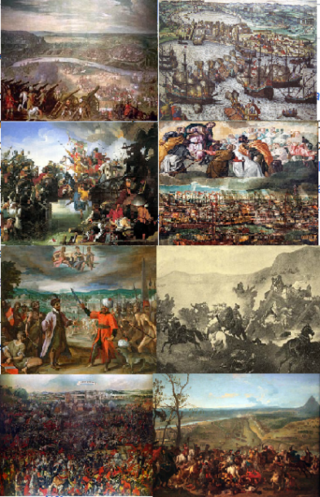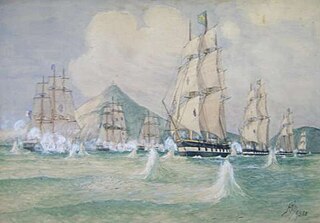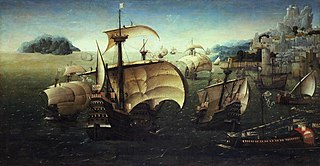
The Battle of Aljubarrota was fought between the Kingdom of Portugal and the Crown of Castile on 14 August 1385. Forces commanded by King John I of Portugal and his general Nuno Álvares Pereira, with the support of English allies, opposed the army of King John I of Castile with its Aragonese and French allies, as well as Genoese mercenaries at São Jorge, between the towns of Leiria and Alcobaça, in central Portugal. The result was a decisive victory for the Portuguese, ruling out Castilian ambitions to the Portuguese throne, ending the 1383–85 Crisis and assuring John as King of Portugal.

The 1383–1385 Portuguese interregnum was a civil war in Portuguese history during which no crowned king of Portugal reigned. The interregnum began when King Ferdinand I died without a male heir and ended when King John I was crowned in 1385 after his victory during the Battle of Aljubarrota.

Dom Francisco de Almeida, also known as the Great Dom Francisco, was a Portuguese nobleman, soldier and explorer. He distinguished himself as a counsellor to King John II of Portugal and later in the wars against the Moors and in the conquest of Granada in 1492. In 1505 he was appointed as the first governor and viceroy of the Portuguese State of India. Almeida is credited with establishing Portuguese hegemony in the Indian Ocean with his victory at the naval Battle of Diu in 1509. Before Almeida returned to Portugal he lost his life in a conflict with indigenous people at the Cape of Good Hope in 1510. His only son Lourenço de Almeida had previously been killed in the Battle of Chaul.
Colonial war is a blanket term relating to the various conflicts that arose as the result of overseas territories being settled by foreign powers creating a colony. The term especially refers to wars fought during the nineteenth century between European armies in Africa and Asia.

The Lancastrian War was the third and final phase of the Hundred Years' War between England and France. It lasted from 1415, when King Henry V of England invaded Normandy, to 1453, when the English lost Bordeaux. It followed a long period of peace from the end of the Caroline War in 1389. The phase is named after the House of Lancaster, the ruling house of the Kingdom of England, to which Henry V belonged.
The military history of Morocco covers a vast time period and complex events. It interacts with multiple military events in a vast area containing North Africa and the Iberian peninsula.
The Battle of Kombi was a decisive battle in the war between Ndongo-Matamba and Portugal during the Dutch period of Angolan history.

The Ottoman–Habsburg wars were fought from the 16th to the 18th centuries between the Ottoman Empire and the Habsburg monarchy, which was at times supported by the Kingdom of Hungary, Polish–Lithuanian Commonwealth, and Habsburg Spain. The wars were dominated by land campaigns in Hungary, including Transylvania and Vojvodina, Croatia, and central Serbia.
The War of the Two Peters was fought from 1356 to 1375 between the crowns of Castile and Aragon. The conflict was a struggle between two claimants to the throne of Castile, Peter of Castile and Peter IV of Aragon. The former Peter was supported by England and several English nobles led by Edward III and his son, while the latter Peter was supported by France. The conflict also brought in the involvement of the kingdoms of Navarre and Portugal. The war resulted in Aragon gaining the upper hand, but it also devastated its economy that was already reeling from the effects of the Black Death.

Francisco Barreto was a Portuguese soldier and explorer. An officer in Morocco during his early life, Barreto sailed to Portuguese India and was eventually appointed viceroy of the colony. After his return to Lisbon, he was tasked with an expedition to southeast Africa in search of legendary gold mines. Barreto died in what is now Mozambique, having never reached the mines.
Rajasinghe I also known as the lion of Sitawaka was a king of Sitawaka, known for his patriotism and fight against the Portuguese invasion of Sri Lanka. Born as Tikiri Bandara to King Mayadunne, he received the name "Rajasimha" after the fierce Battle of Mulleriyawa.

The Federalist Revolution was a civil war that took place in southern Brazil between 1893 and 1895, fought by the federalists, opponents of Rio Grande do Sul state president, Júlio de Castilhos, seeking greater autonomy for the state, decentralization of power by the newly installed First Brazilian Republic and, arguably, the restoration of the monarchy.

Moroccan–Portuguese conflicts refer to a series of battles between Morocco and Portugal throughout history including Battle of Tangier, Fall of Agadir and other battles and sieges in the Moroccan coast.
Fernando de Castro was a 15th-century Portuguese nobleman, diplomat and military figure. Fernando de Castro was the 1st Lord of Paúl de Boquilobo. He was a member of the royal council of John I of Portugal, and governor of the household of Prince Henry the Navigator.

The Treaty of Tadla was a treaty signed in 1527 between the rival Moroccan dynasties of the Marinid Wattasids, in the north of the country, and the southern Saadis. The treaty followed an inconclusive military encounter between the two parties at Tadla.

The naval Battle of Montevideo of 21 October 1823 formed a part of the Siege of Montevideo, as Brazilian forces sought to capture the last Portuguese redoubt in the Cisplatina during the War of Independence of Brazil.

The War of the League of the Indies was a military conflict in which a pan-Asian alliance formed primarily by the Sultanate of Bijapur, the Sultanate of Ahmadnagar, the Kingdom of Calicut, and the Sultanate of Aceh, referred to by the Portuguese historian António Pinto Pereira as the "league of kings of India", "the confederated kings", or simply "the league", attempted to overturn Portuguese presence in the Indian Ocean. This was attempted through a combined assault on some of the main possessions of the Portuguese State of India: Malacca, Chaul, Chale fort, and the capital of the maritime empire in Asia, Goa.

The Siege of Mazagan of 1562, also known as the Great Siege of Mazagan was an armed engagement that took place in the modern city of El Jadida, then known as Mazagan, between Portuguese forces and those of the Saadi dynasty, which had unified Morocco a few years prior.

Portuguese Asilah covers the period of Portuguese rule over Asilah, today a city in Morocco. The territory was ruled by the Kingdom of Portugal from 1471 to 1550 and again between 1577 and 1589.












